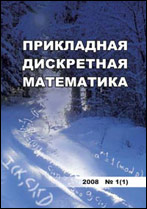|
This article is cited in 1 scientific paper (total in 1 paper)
Mathematical Backgrounds of Informatics and Programming
Construction of a Hamming network based on a crossbar with binary memristors
M. S. Tarkov
Rzhanov Institute of Semiconductor Physics SB RAS, Novosibirsk, Russia
Abstract:
The properties of analog and binary memristors (resistors with memory) are described. The memristors can be used for the hardware implementation of neurons synapses. The memristor matrices are called crossbars. The binary memristors, whose resistance takes only two values (maximum and minimum), are based on the switching filament mechanism and are distributed more widely than analog memristors. They are much more stable to statistical fluctuations compared to analog memristors. The Hamming associative memory's hardware realization based on the use of a binary memristors crossbar and CMOS circuitry is proposed. The maximum binary memristor resistance corresponds to the stored reference vector component value $-1$, and the minimum resistance corresponds to the value $+1$. It is shown that the binary memristors crossbar realizes the Hamming network first layer properties according to which the output first layer neuron signal is non-negative. This signal is maximal for a neuron with the reference vector closest to the input vector. For a given reference vector dimension, the relationship between the maximum and minimum binary memristors resistances is obtained. It guarantees the Hamming network first layer correct operation. Simulation in the LTSPICE system of the proposed Hamming memory scheme confirmed its operability.
Keywords:
associative Hamming memory, memristor, crossbar, CMOS-technology, LTSPICE.
Citation:
M. S. Tarkov, “Construction of a Hamming network based on a crossbar with binary memristors”, Prikl. Diskr. Mat., 2018, no. 40, 105–113
Linking options:
https://www.mathnet.ru/eng/pdm625 https://www.mathnet.ru/eng/pdm/y2018/i2/p105
|

| Statistics & downloads: |
| Abstract page: | 333 | | Full-text PDF : | 183 | | References: | 32 |
|




 Contact us:
Contact us: Terms of Use
Terms of Use
 Registration to the website
Registration to the website Logotypes
Logotypes








 Citation in format
Citation in format 
